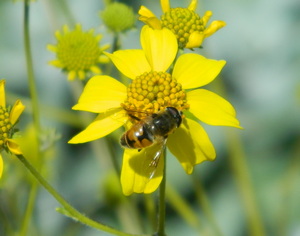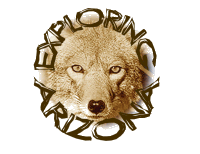Food Gathering

In summet when there are flowels blooming, a worker bee spends the first three weeks of its life in the nest The remaining three weeks of its six week life it gathers food. Let us follow a young worker bee on its first trip to collect food. It finds its way along an invisible scent trail to the place where there are flower s. When close, ii is attracted by the bright colors of the flower. It usually lands near the source of pollen or nectar, a sweet liquid made by some flowers. In the flower in the picture, the brilliant yellow shows the reward area. This is the place on the flower where pollen or nectar can be found. The colors of flowers are usually the colors bees are able to see. These include some colors, such as ultra-violet, that we cannot see. Color, shape and odor are the three main flower attractants for bees. Nectar and pollen are the reward.
At first the young bee is clumsy and makes many mistakes. Soon, however, it learns to bite and brush its mouth parts and body against the flower parts that are covered with pollen. Notice that the pollen in this flower is raised up on little stalks. The bee hovers, or hangs, fluttering in the air above the flower, as it combs its body with fine-toothed combs on the inside of its legs. Pollen is passed from leg to leg and packed into the pollen baskets located on the hind legs.
A bee may also collect nectar, a sweet liquid produced by some flowers. The bee sips the nectar into its honey stomach located in the front part of its abdomen. After searching for food bees carry pollen and nectar back to the hive. The food may be used in just a few hours or stored for many months. Pollen provides the protein and fat needed in the honey-bee's diet while nectar provides carbohydrate or sugar. After delivering its load the bee returns to the same area for more pollen or nectar. Each food-collecting bee learns to visit one kind of flower located in a small area of perhaps a few square yards. A single bee may make up to 40 trips a day. Honey-bees can collect food only in good weather. When rain washes away the pollen and nectar, the bees stay in their nest, or hive, until new flowers bloom. In cold weather and on very windy days, they stay inside the hive where they are protected from bad weather.
Bees compete successfully with other insects for the limited supply of pollen and nectar made by flowers, because they have an efficient way of telling other bees where there is food. When a successful food gatherer returns to the nest, the bees that have never collected food before smell the scent of the nectar and pollen. They also taste the nectar offered to them by the returning bee and learn the flavor and sugar concentration of it. In addition, the returning bee does a special dance on the comb. The direction in which the bee points as it dances is related to the direction of the food source. At the same time the bee also moves, or wags its body, back and forth pro-ducing sounds. The wagging movements and the sounds are related to the distance to food from the hive. By touching this dancing bee and sensing the sounds, other bees seem to learn the direction and distance of the food. Thus it is possible for bees in the nest to learn many things that can help them find the food. However, not enough experiments have been done to find out how much of this information is used.
The Bees section was created with special thanks to Louis Juers (Arizona State Parks & Trails) for providing information used in this section. Additional information and digital materials were obtained from some of the following organizations. We would like to thank them for all their dedication and hard work within their profession.
|









